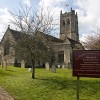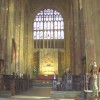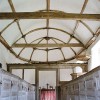On January 15th 1705 an extraordinary marriage was solemnised in a Dorchester church. Extraordinary, because neither party to the union, especially the bride, was committed to the other out of mutual affection. Furthermore, the groom could scarcely have imagined that the ceremony would launch them both on a fateful journey that would end in capital crime and capital punishment. Neither could he have imagined that before spring turned to summer that year he would be dead.
The groom was Thomas Channing, a goodly tradesman of a Maiden Newton family, who had established his own successful grocery business in Dorchester; his bride was a reluctant, rebellious teenager called Mary Brooks. And they were wedded not out of love but purely out of convenience: in deference to the wish of the bride’s parents to see their daughter suitably placed with a respected, financially secure citizen.
The chain of events, which culminated in this peculiar tryst of fate, began some 18 years before with the birth of Mary Brooks in May 1687. Her father Richard and mother Elizabeth were keen to give their daughter the kind of education common to children of their social standing. Mary excelled in reading and writing, but her parents neglected to lend equal weight to the girl’s moral and religious instruction.
Whether or not this was a contributory factor, the girl manifested a latent sluttish disposition, which may have been aggravated by emotional depravation caused by her mother’s frequent absences. It was thought that the pastoral simplicity and rude country acumen of 18th century Dorset was no environment in which to equip a country girl for the niceties of high society, and so Mary was packed off to Exeter, London and elsewhere to gain experience of English higher society.
But this extraordinary degree of liberty was to exert further negative consequences on Mary Brook’s already weak character and tainted persona. Her sluttish manner gave way to vanity, promiscuity and riotous living. Every two weeks she would attend the local dance school, staying on for a night of frivolity and mirth with other young friends. She was ever at the homes of her neighbours, luring them into orgies of gluttony and intemperance while frittering the night away in gay abandon.
She was later to disown these “friends” when she began a loose affair with a local man. The pair would frequent public houses, where the wayward teenager would entertain her date with wine and shower him with gifts such as ruffles and cravats. Mary would willingly cover the expenses for these excesses, but her generosity cut deeply into her solvency. To financially support her highly social lifestyle Mary cajoled, or even conspired to rob, her parents of substantial sums, aided by some of her closest friends.
Naturally her cavorting and Jezebellian ways became the talk of Dorchester’s gossips, but Mary continued to drift from one extreme of pleasure-seeking to another. One citizen, who did not even know the Brooks family, even sent Mary’s parents a letter of complaint about their daughter’s wayward conduct. These correspondences would increase as Mary’s excesses increased. Clearly Dorchester’s busybodies had blown any hope the girl may have entertained of keeping her activities under wraps from her parents. Although Richard Brooks was shamed by his daughter’s behaviour and expressed his displeasure, Mary took scant notice.
Once the revelations of the extent of Mary’s conduct had come home to her parents they concluded that the best remedy lay in finding Mary an eligible husband – probably in the hope that she would knuckle down to the sober responsibilities of family life. To make the proposition more attractive they used the prospect of a considerable fortune as a carrot to dangle before several Dorchester bachelors. But of these only one would rise to the bait: Thomas Channing.
Although the grocer was an acceptable suitor in the eyes of the Brooks, their daughter’s affections lay elsewhere. Channing himself turned his attentions to another prospective bride for a time, but the iron will of Mrs Brooks proved to strong to countermand. As for Mary, her rejection of Thomas brought about confinement to her room for several days in punishment. Eventually, for the sake of her freedom, she grudgingly agreed to marry Channing.
After an initial postponement of 24 hours the unhappy union of Thomas Channing and Mary Brooks was consummated. Yet after a while Mary, who before and after was plotting how to rid herself of parental control, came to look on her marriage as the way to achieve this. Shortly before she had also been roused to anger when her current fancy had refused to marry her.
Amazingly the wedding party lasted for two days with the full knowledge of the Brooks, but apparently the total ignorance of the Channings. Only weeks earlier their son had told them he had relinquished all thought of marrying Mary, but after the wedding he changed his mind. By now though, a fateful dye had been cast. When the marriage was barely three months old Mary began an affair with yet another man, a visitor to Dorchester recorded only as Mr Naile, upon which she lavished her accustomed costly entertainment. She even persuaded Thomas to let Mr Naile take his place in their bed. That he did so most likely occasioned the illegitimate conception that added the drop of gall to Mary’s cup of tragedy.
By now, poor Thomas had become an inconvenient hindrance to his wife’s nuptial preferences. On April 17th she administered to her husband a dose of mercury purchased from the maid of the apothecary the previous day. After eating the dish of rice milk Thomas was violently ill and began vomiting. The following day, prompted possibly by the suspicion that he was being poisoned, he made out a last will and testament entirely disinheriting his wife. Following another three days of agony and unremitting pain the grocer died on April 21st. Following the post-mortem sixty to eighty people attended Channing’s funeral at St. Mary’s back in Maiden Newton.
Even before Channing died however, Mary had decamped. She went into hiding for 30 hours, first to a safe house in Dorchester, then into a wood four miles away. From there, with the aid of a friend’s employee, she made it to the home of a relation of her sister-in-law who lived in Charlton Worthorn in Somerset. Once he had learnt of Mary’s purchase of the mercury, Thomas’s father then organised a wide search. On Sunday Mary’s accomplice, following the offer of a reward and out of fear of being charged as an accessory, brought her back. That night Mary learnt of her husband’s death, but showed no emotion or concern.
In the morning she was brought before the justices at Dorchester for questioning. During the trial Mary had the opportunity to defend herself, but against the weight of two barristers and many prosecution witnesses the jury took only half-an-hour to find her guilty. On pronouncement of the death sentence Mary pleaded “her belly” (postponement on account of her pregnancy.) Until her baby had been born the sentence could not be carried out.
This pregnancy, of course, was a critical, if unintended artefact in the Channing case, providing an 8-month window of opportunity for appeals against the sentence to be lodged. Richard Brooks lost no time in petitioning Queen Anne and Mary’s eldest brother presented a petition signed by several Dorchester citizens to the judge at Wells. Mary’s mother sought the help of a lady, but all these efforts were to no avail. Multifarious deaf ears could not save a sinful teenager from the terror and humiliation of a public hanging.
While in prison much pressure was put on Mary to confess and repent, but she would maintain her innocence to the end. At first the Brooks were able to pay for respectable accommodation for their fecund daughter, but later seemed to lose concern for her welfare. Their support payments lapsed, so that Mary had to be relocated to a much more spartan cell with a bed made from only canvas tilting of an old wagon. It was in here on December 19th that Mary delivered a son that was immediately baptised at her request. The mother refused to have the baby withdrawn from her care.
But the opportunity for maternal care almost never arose. Soon after the birth Mary was smitten with fever and nursing the baby greatly weakened her. In these last tragic days Elizabeth Brooks was at Mary’s side constantly. On March 8th 1706 Mary was again summoned to the bar and asked if she could show just reason why the death sentence should not be passed. She could not, and so was told to prepare for death. Various clergy began a campaign to persuade Mary to repent of her sins, but without success. Yet Mary asked to be baptised (the Brooks were Baptists, who did not believe in infant baptism.) But how could the chaplain baptise one who wouldn’t repent? After a special dispensation from the Bishop of Bristol however, Mary was baptised on the 17th of March.
Only four days later on March 21st 1706 Mary Channing’s time had come. From the prison she was brought to her place of execution at Maumbury Rings on the outskirts of Dorchester, where a crowd of over three thousand had gathered for the macabre ordeal. Burning at the stake was the customary execution for women until the end of the 18th century. At 5 o’clock in the afternoon Mary was bound by the neck to a post while faggots piled up around her were lit. But the 19 year-old was already dead from strangulation by the noose. Then, with no sense of shock or revulsion, the multitude dispersed as Mary Channing’s mortal existence was consumed by fire.
As to the fate of her son, this seems to have been lost to history. Did he die in infancy? Was he perhaps brought up in a workhouse or even adopted by his grandparents or another family? Did he stay in Britain or emigrate to seek his fortune overseas? We may never know.



